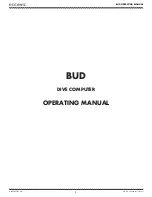
15
5.6 Certifications
Safety:
●
UL 61010-1 (3rd Edition)
●
CAN/CSA-C22.2 No. 61010-1-04
●
IEC 61010-1:2010 (3rd Edition)
Immunity:
EN 61326: 2002 (Industrial Locations)
Electrostatic Discharge:
EN 61000-4-2
Radiated RF Immunity:
EN 61000-4-3
Electrical Fast Transient / Burst:
EN 61000-4-4
Surge Immunity:
EN 61000-4-5
Conducted RF Immunity:
EN 61000-4-6
Voltage Dips, Interrupts:
EN 61000-4-11
Emissions:
●
FCC Part 15, Class B
●
EN 55022: 1994, Class B
5.7 Environmental
Operating Temperature:
-40°C to +75°C (-40°F to 167°F)
Altitude:
Up to 2000 m (6560 ft)
Operating Humidity:
non-condensing, 5 to 90% relative humidity (RH) up to 40°C, decreasing
linearly to 50% RH at 55°C.
Pollution:
POLLUTION DEGREE 2 - Normally only non-conductive pollution; occasionally, a
temporary conductivity caused by condensation must be expected.
Indoor Use:
Suitable for indoor use.
Outdoor Use:
Suitable for outdoor use if mounted inside an electrical enclosure (Hammond Mfg.,
Type EJ Series) rated NEMA 3R or 4 (IP 66).
5.8 Mechanical
Enclosure:
High impact, ABS/PC plastic
Flame Resistance Rating:
UL 94V-0, IEC FV-0
Size:
6.02 in. × 3.35 in. × 1.50 in. (153 mm × 85 mm × 38 mm)
Connectors:
Euroblock pluggable terminal blocks
Green:
up to 12 AWG (2.5 mm
2
), 600 V, screw torque 4.4 lbf·in (0.5 N·m)
Black:
up to 12 AWG (2.5 mm
2
), 300 V, screw torque 4.4 lbf·in (0.5 N·m)
5.9 FCC Information
This equipment has been tested and complies with the limits for a Class B digital device, pursuant
to part 15 of the FCC Rules. Operation is subject to the following two conditions: (1) This device
may not cause harmful interference, and (2) this device must accept any interference received,
including interference that may cause undesired operation.
The FCC limits are designed to provide reasonable protection against harmful interference in a
residential installation. This equipment generates, uses and can radiate radio frequency energy
and, if not installed and used in accordance with the instructions, may cause harmful interfer-
ence to radio communications. However, there is no guarantee that interference will not occur in
a particular installation. If this equipment does cause harmful interference to radio or television
reception, which can be determined by turning the equipment off and on, the user is encouraged to
try to correct the interference by one or more of the following measures:
●
Reorient or relocate the receiving antenna.
●
Increase the separation between the equipment and receiver.
●
Connect the equipment to a circuit different from that to which the receiver is connected.
●
Consult the dealer or an experienced radio/TV technician for help.


































